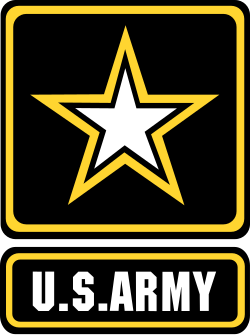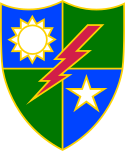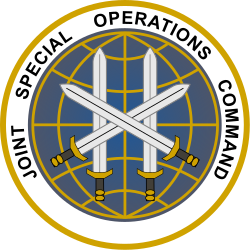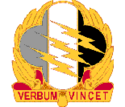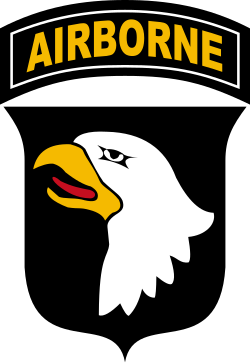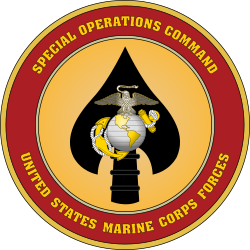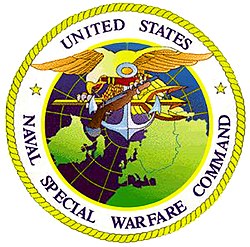United States Army Special Operations Command
United States Army Special Operations Command | |
|---|---|
Verbandsabzeichen als Ärmelabzeichen | |
| Aufstellung | 1. Dezember 1989 |
| Staat | Vereinigte Staaten |
| Streitkräfte | Streitkräfte der Vereinigten Staaten |
| Teilstreitkraft | Heer (United States Army) |
| Stärke | 30.000 |
| Unterstellung | United States Special Operations Command |
| Führung | |
| Kommandierender General (Commanding General) | Lieutenant General Jonathan P. Braga |
Das United States Army Special Operations Command (kurz USASOC oder ASOC) ist das Führungskommando für die Spezialeinheiten der US Army: U.S. Army SOF (ARSOF). Das Kommando untersteht selbst dem US Special Operations Command (USSOCOM) und wurde am 1. Dezember 1989 aufgestellt.[1] Es befindet sich in Fort Liberty (North Carolina).
Organisation
USASOC koordiniert alle Einsätze der Army-Spezialeinheiten mit dem US Special Operations Command.
Struktur
Mit rund 33.805 Mann (Stand 2020) an Personal ist das USASOC eines der größten Hauptkommandos der US Army. Ihm unterstehen sechs weitere Brigaden und Regimenter.
- 1st Special Forces Command (Airborne) (USASFC), auch als Green Berets bekannt.
- United States 4th Psychological Operations Group (Airborne) (4th PSYOP Gp) zuständig für Öffentlichkeitsarbeit und psychologische Kriegführung.
- United States 8th Psychological Operations Group (Airborne) (8th PSYOP Gp) zuständig für Öffentlichkeitsarbeit und psychologische Kriegführung.
- United States 95th Civil Affairs Brigade (Airborne) (95th CA Bde), zuständig für Personal- und Verwaltungsangelegenheiten.
- 528th Sustainment Brigade (Special Operations) (Airborne) (SBSO(A)), gegründet am 2. Dezember 2005 (davor Special Operations Support Command) Es ist zuständig für die Logistik und Sanitätsversorgung.
- United States Army Special Operations Aviation Command
- United States 160th Special Operations Aviation Regiment (Airborne) (160th SOAR), bekannt als „Night Stalkers“ stellt es den Lufttransport der Sondereinsatzverbände sicher.
- United States Army John F. Kennedy Special Warfare Center and School (USAJFKSWCS), die Schule der Army-Spezialeinheiten.
- United States Army Rangers (75th RGR RGT), auch als „75th Ranger Regiment“ bekannt.
Eine Besonderheit bildet allerdings das „1st Special Forces Operational Detachment-Delta“, die Delta Force. Obwohl eine Einheit der US Army, wird diese nicht vom USASOC geführt. Sie untersteht direkt dem US Joint Special Operations Command (JSOC).
Organigramm

Ausrüstung
Im Gegensatz zum Rest der US Army verwenden Einheiten der USASOC die Glock 19.[2]
Führung
| Name | Beginn der Berufung | Ende der Berufung |
|---|---|---|
| Lieutenant General Jonathan P. Braga | 13. August 2021 | |
| Lieutenant General Francis M. Beaudette | 8. Juni 2018 | 13. August 2021 |
| Lieutenant General Kenneth E. Tovo | 1. Juli 2015 | 8. Juni 2018 |
| Lieutenant General Charles T. Cleveland | 24. Juli 2012 | 1. Juli 2015 |
| Lieutenant General John F. Mulholland Jr.[3] | 7. November 2008 | 24. Juli 2012 |
| Lieutenant General Robert W. Wagner | 8. Dezember 2005 | 7. November 2008 |
| Lieutenant General Philip R. Kensinger | 29. August 2002 | 8. Dezember 2005 |
| Lieutenant General Bryan D. Brown | 11. Oktober 2000 | 29. August 2002 |
| Lieutenant General William Tangney | 1997 | 11. Oktober 2000 |
| Lieutenant General Peter Schoomaker | Oktober 1996 | 1997 |
| Lieutenant General James T. Scott[4] | 1993 | 1996 |
Weblinks
- Offizielle Website des US Army Special Operations Command (englisch)
- Official 2009 SOCOM Factbook ( vom 18. März 2009 im Internet Archive) (PDF; 4,3 MB), S. 10 ff. (englisch)
- USASOC bei globalsecurity.org (englisch)
- USASOCOM bei delta-green.com ( vom 17. April 2012 im Internet Archive) (englisch)
Einzelnachweise
- ↑ A Brief History of Special Operations Forces. HQ USASOC Special Operations Forces Information, archiviert vom am 21. Oktober 2010; abgerufen am 1. Januar 2014 (englisch, 1 Dec 89 – 1. U.S. Army Special Operations Command activated as the 16th major Army command).
- ↑ Matthew Cox: Army Pushes Back Against Reported Interest in Glock Contract. In: Military.com. 24. März 2016, abgerufen am 16. August 2016 (englisch).
- ↑ Lt. Gen. John F. Mulholland Jr. Commanding General. U.S. Army Special Operations Command, archiviert vom am 21. Oktober 2010; abgerufen am 1. Januar 2014 (englisch).
- ↑ Lieutenant General James T. Scott ’64 ( vom 12. März 2016 im Internet Archive)
Auf dieser Seite verwendete Medien
Autor/Urheber: Noclador, Lizenz: CC BY-SA 3.0
Structure United States Army Special Operations Command.
4th Infantry Division shoulder insignia :
I created this work during the course of my official duties. As a United States Army soldier, it is considered the work of the United States Federal Government, and as such is in the public domain. -- Steven Williamson (HiB2Bornot2B) - talk 15:49, 26 July 2007 (UTC)
The official logo of the United States Army (USA). It can be seen on the official United States Army website in September 2001.
US 1st Cavalry Division
SHOULDER SLEEVE INSIGNIA
- Description: On a yellow triangular Norman shield with rounded corners 5 1/4 inches in height overall, a black diagonal stripe extending over the shield from upper left to lower right and in the upper right a black horse's head cut off diagonally at the neck all within a 1/8 inch green border.
- Symbolism: Yellow, the traditional cavalry color, and the horse's head refer to the division's original cavalry structure. Black, symbolic of iron, alludes to the transition to tanks and armor. The black diagonal stripe represents a sword baldric and is a mark of military honor; it also implies movement "up the field" and thus symbolizes aggressive elan and attack. The one diagonal bend, as well as the one horse's head, also alludes to the division's numerical designation.
- Background: The shoulder sleeve insignia was originally approved January 3, 1921 with several variations in colors of the bend and horse's head to reflect the subordinate elements of the division. The current design was authorized for wear by all subordinate elements of the division on December 11, 1934 and previous authorization for the variations was cancelled.
3rd Infantry Division Shoulder Sleeve Insignia
75th Infantry Regiment (Ranger) Distinctive Unit Insignia
1st Infantry Division Combat Service Identification Badge
Autor/Urheber:
MrInfo2012
, Lizenz: CC BY-SA 3.0The shoulder sleeve insignia of 2d Stryker Cavalry Regiment
75th Ranger Regiment Distinctive Unit Insignia
25th Infantry Division Shoulder Sleeve Insignia
The 11th Armored Cavalry Regiment Shoulder Patch
Shoulder Sleeve Insignia of the United States Army Special Operations Command.
Description: On a red stylized spearhead with a 1/8 inch red border, 3 1/2 inches in height and 2 inches in width overall, a black Fairbairn-Sykes dagger. A black tab with "AIRBORNE" in red letters is attached above the insignia.
Symbolism: The stylized spearhead alludes to the shoulder sleeve insignia worn by the lst Special Service Forces and signifies the heritage and traditions that the US Army Special Operations Command will perpetuate. The unsheathed black dagger symbolizes total military preparedness and has long been associated with Army special operation forces. The airborne tab designates the command's airborne status.
Background: The shoulder sleeve insignia was approved effective 1 December 1989.The official insignia for the 11th Airborne Division. The Army will re-designate U.S. Army Alaska and two Alaska-based brigade combat teams this summer as the 11th Airborne Division Headquarters and the 1st and 2nd Brigade Combat Teams, 11th Airborne Division. This re-designation is an outgrowth of the Army’s January 2021 Arctic Strategy and sets us on the path towards a force that is more appropriately manned, trained, and equipped for the Arctic environment.
160th SOAR emblem
4th PSYOP Group Unit Insignia
Shoulder Patch of 173rd Airborne Brigade
U.S. Army Special Operations Aviation Command Shoulder Sleeve Insignia
3rd Armored Regiment Shoulder Sleeve Insignia
1st Special Forces Operational Detachment Delta Unit Patch
US Army 1st Armored Division Shoulder Sleeve Insignia
- Upon a five pointed white star whose points lie in the circumference of an imaginary circle 3-1/2 inches (8.89 cm) in diameter a Native American's head with war bonnet in profile, face red, bonnet blue with outline of feathers in blue.
- The star to be superimposed upon a black shield, of dimensions such that the points of the star shall lie at a distance of 1/8 inch (.32 cm) from the perimeter.
Symbolism:
- The star has played an important part in our history from the days of the Colonies to the present time.
- The Native signifies the first and original American.
- These devices were originally established by the division to use as vehicle markings and to identify the vehicles as all American.
Background:
- The shoulder sleeve insignia was originally authorized for the 2d Division on 6 Nov 1918, officially announced by The Adjutant General letter, 21 Jun 1922, amended to correct the description on 7 Nov 1927 and redesignated for the 2d Infantry Division on 1 Aug 1942.
Work of Federal Government
Shoulder sleeve patch of the U.S. 10th Mountain Division The 10th Mountain shoulder patch consists of a white-bordered powder keg. The powder keg is in blue and, superimposed on it are two red bayonets in saltire so as to form the Roman numeral “X”. The bayonets represent the Infantry and the numerical designation of the Division. This is the Shoulder Sleeve Insignia; the Distinctive Unit Insignia can be found at Image:10th Mountain Division-distinctive unit insignia.jpeg.
On a blue powder keg-like background, with a white border, two bayonets in saltire throughout scarlet fimbriated white. The blue background and the bayonets are symbolic of infantry while the position of the bayonets in saltire simulates the numerical designation of the organization.Seal of Naval Marine Corps Forces Special Operations Command realized thanks to File:United_States_Special_Operations_Command_Insignia.svg and File:Emblem of the United States Marine Corps.svg
Logo United States Naval Special Warfare Command
95th Civil Affairs Brigade Shoulder Sleeve Insignia
Image of Special Operations Support Command crest
Distinctive Unit Insignia for the U.S. Army John F. Kennedy Special Warfare Center and School at Fort Bragg, N.C.






